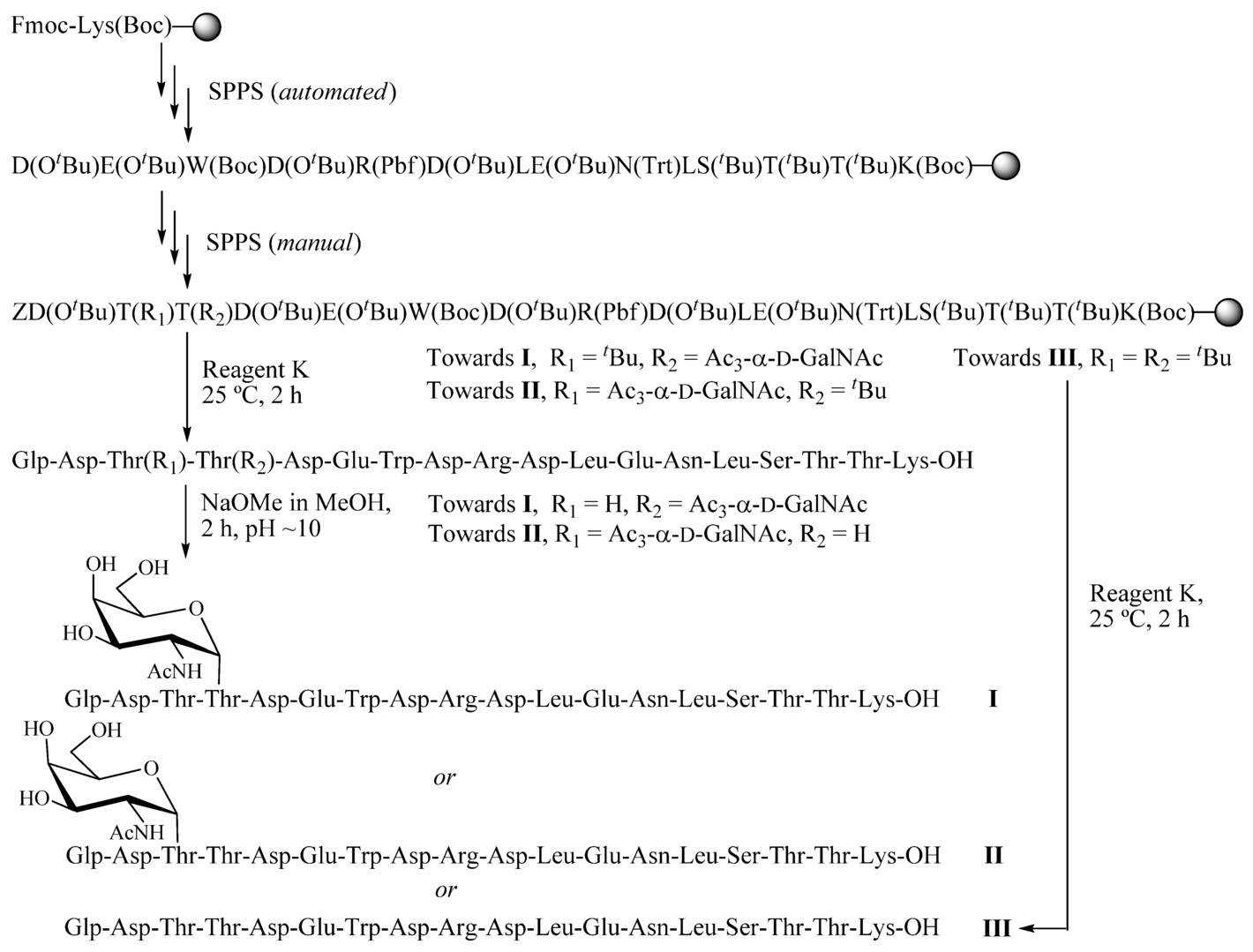Chemical Synthesis of Glycoprotein
The Introduction and Necessity for Protein Glycosylation
Protein glycosylation is one of the most common co- and post- translational modifications for proteins. The glycoproteins are ubiquitous in the world and present important roles in multiple physiological processes, including cell growth, cell differentiation, and cell adhesion. To better understand the structure-activity relationships (SARs) and functions, the synthesis of glycoproteins is essential. In recent decades, a series of synthetic approaches have been developed.
 Fig.1 Synthesis of three glycopeptide fragments taken from rat epididymal cysteine-rich secretory protein-1 (Crisp-1).1, 2
Fig.1 Synthesis of three glycopeptide fragments taken from rat epididymal cysteine-rich secretory protein-1 (Crisp-1).1, 2
Proteins O-glycosylation affect a series of biological functions and immunity. Solid-phase O-glycopeptide synthesis (SPGPS) is a building block-based method to obtain glycosylated peptides with different sugar moieties on different amino acid side chains. The SPGPS technology has been also applied in drug discovery, such as the construction of glycopeptide microarray chips. Furthermore, the solid-phase hybrid glycopeptide ion program and fluorine labeling method (SHGPFT) is a novel solid-phase synthesis method to prepare O-linked glycopeptides, including the pentapeptide with a monosaccharide motif.
N-glycosylation is the important protein posttranslational modification type that the oligosaccharide would be transferred to asparagine within the consensus sequence Asn-X-Ser/Thr. In general, there are different approaches for N-glycosylation preparation, including linear, convergent, and thioacid-mediated synthesis. The novel-developed tripeptide building block approach allows the synthesis of aspartic thioacid-containing peptides via fluorenylmethyloxycarbonyl (Fmoc)-SPPS.
The indiscriminate convergent synthesis refers to the novel protein glycosylation methods that can be divided into chemoselective, site-specific, and site-selective. IME involves the conversion of the nitrile in the cyanoethyl thioglycoside to the methyl imidate group after exposure to sodium methoxide or methanol HCl. What’s more, the Diels-Alder chemistry has been used to modify glycosylated human serum albumin (HSA) with a series of glycosides to incorporate a conjugated diene under mild conditions.
Multiple approaches for chemoselective and site-specific glycosylation have been developed to introduce carbohydrate moieties at specific sites of peptides and proteins. For example, iodoacetamide-containing mono- and oligosaccharides have been used for site-specific glycosylation of cysteine-containing peptides/proteins. The selectivity and predictability of protein glycosylation can also be increased with multiple methods.
In order to determine precise structure-activity relationships, structure-activity glycosylation is necessary. Through a combination of site-directed mutagenesis and chemical modification, both regio- and glycan-specific glycosylation of proteins are allowed. In addition, a new generation of cysteine site-selective protein glycosylation strategy relies upon selenenylsulfide-mediated conjugation has been developed to achieve multi-site selective glycosylation.
Native chemical ligation (NCL) is the novel technology that allows to achieve close or even match the synthetic chain length of naturally occurring glycoproteins. This process involves a chemoselective reaction between the N-terminal cysteine residue of one peptide and the C-terminal thioester of another peptide. The connection reaction is mainly carried out by thioesterification to generate natural peptide bonds. Using SPPS and NCL methodology, the glycosylated fragment of RNase has been successfully synthesized.
Creative Biolabs has been a long-term expert in the field of glycomics. As a pioneer and the undisrupted global leader in glycan research, we offer a variety of products and services including custom glycoprotein synthesis. If you are interested in our products or services, please do not hesitate to contact us for more detailed information.
References
-
Liu, Mian, David W. Hamilton, and George Barany. "Solid-phase synthesis and evaluation of glycopeptide fragments from rat epididymal cysteine-rich secretory protein-1 (Crisp-1)." Molecules 15.9 (2010): 6399-6410.
-
Under Open Access license CC BY 3.0, without modification.
For Research Use Only.
Resources

 Fig.1 Synthesis of three glycopeptide fragments taken from rat epididymal cysteine-rich secretory protein-1 (Crisp-1).1, 2
Fig.1 Synthesis of three glycopeptide fragments taken from rat epididymal cysteine-rich secretory protein-1 (Crisp-1).1, 2



